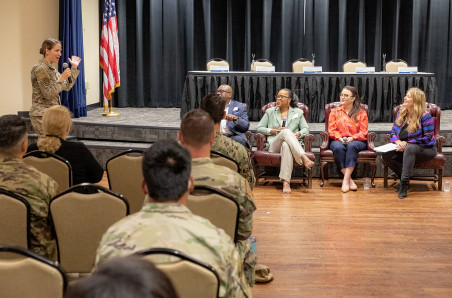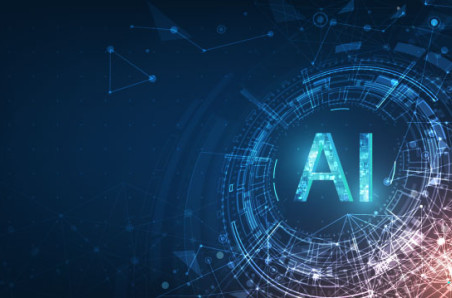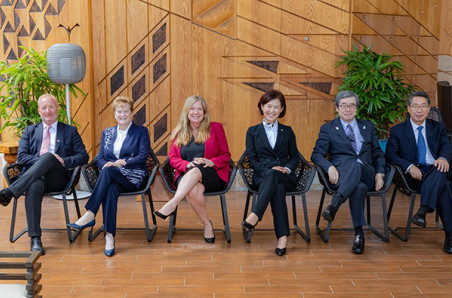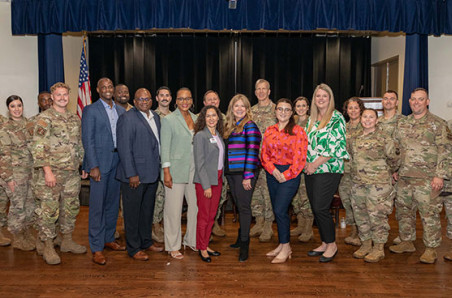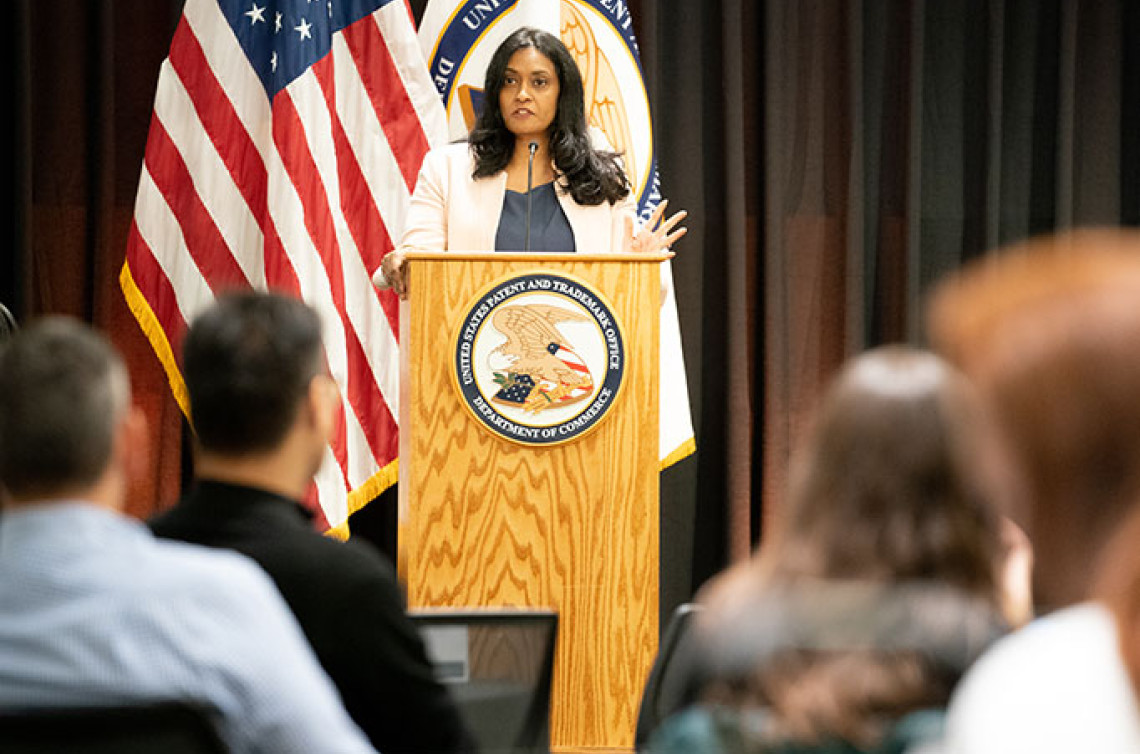
On September 27, 2023, Commissioner for Patents Vaishali Udupa spoke at the USPTO's fourth AI/ET Partnership meeting about the USPTO's critical role in advancing emerging technologies and artificial intelligence. (Photo by Jay Premack/USPTO)
Latest updates on artificial intelligence and intellectual property
When it comes to artificial intelligence (AI), there is enormous potential for our country and for solving world problems — but there are significant risks as well. To shape the future of AI, we must act quickly, but also thoughtfully and with your input.
Since taking office, President Biden and the entire the Biden-Harris Administration have moved with urgency to seize the tremendous promise and manage the risks posed by AI. The Biden-Harris Administration is currently developing an executive order that will ensure the federal government is doing everything in its power to advance safe, secure and trustworthy AI, and manage its risks to individuals and society. Our Administration will also pursue bipartisan legislation to help America lead the way in responsible innovation. As we advance this agenda at home, the Administration will continue working with allies and partners to establish a strong international framework to govern the development and use of AI worldwide.
The USPTO and our sister agencies within the Department of Commerce, as well as the U.S. Copyright Office, play a critical role in this work. One of the USPTO's top priorities is to ensure that the United States maintains its leadership in innovation, especially in emerging technologies (ET) such as AI. Our AI efforts align closely with the Administration's whole-of-government approach to AI, including the National AI Initiative that seeks to advance U.S. leadership in AI. That is why, under my leadership, the USPTO created the AI/ET Partnership. Over the last year, the USPTO's AI/ET Partnership has worked closely with the AI/ET community to gather public feedback through a series of meetings on topics related to AI and innovation, biotech, and intellectual property (IP) policy.
In collaboration with you, we have been working to swiftly, but also responsibly, incorporate AI into our work so that we can better serve the American public and increase the robustness and reliability of IP rights. We are integrating AI technologies into our next-generation tools to enhance the quality and efficiency of patent and trademark examination. Our examiners have conducted over 1.3 million searches using AI search tools. These tools also find potential foreign prior art relevant to their examination of a patent application by searching patent documents from over 60 different countries. We are assessing approaches for making these AI search tools publicly available. We are also working to extend search to images for design patents. And, our Trademarks organization is also looking to develop AI capabilities in image searching, classification, and identification of goods which will better assist our more than 750 trademark examining attorneys examining applications for trademark registrations.
We also have several user-facing AI initiatives in development and public beta, to help the public better navigate the patent and trademark systems. The USPTO Virtual Assistant enhances customer service by providing immediate, targeted answers to common questions. While currently available on several Trademark pages; we will be adding the tool to more USPTO pages soon. Our Inventor Search Assistant tool allows you to search for your own prior art to help determine if your invention is patentable (Learn more in this Inventors Digest article). Last year, we held an AI research competition where more than 2,300 competitors from over 80 countries created AI models for a patent phrase-to-phrase matching challenge. We offer an AI Patent Dataset that — using a machine-learning (ML) approach that analyzed patent text and citations in patent applications and other documents — identifies patents issued from 1976-2020 with one or more AI technology components, including ML, natural language processing, computer vision, speech, and more.
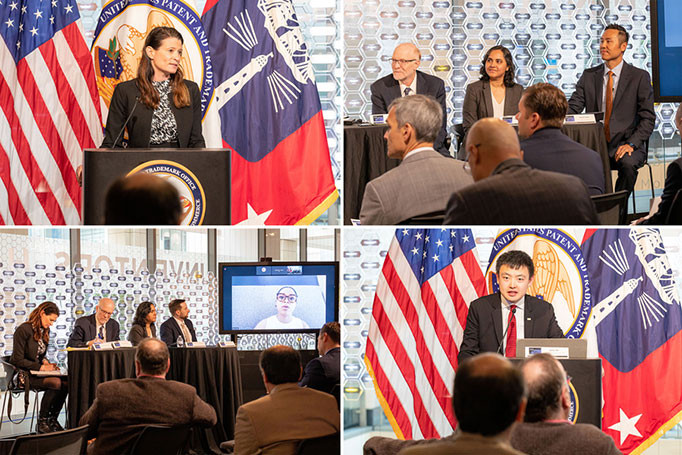
On April 25, 2023, the USPTO held one of several public listening sessions on AI and inventorship. (Photo by Michel Cleveland/USPTO)
Our AI/ET Partnership Meeting on September 27 explored the many ways that AI is shaping the work of both the USPTO and those who practice before us, along with the role of USPTO data in advancing state-of-the-art AI research and AI throughout the innovation economy. Attendees heard from a distinguished and diverse lineup of AI researchers, IP practitioners, USPTO technologists, and interagency partners. And our economists demonstrated some of our AI data and research initiatives.
Given the rapid adoption of AI, we are moving swiftly and carefully – including on patent examiner training. In our report, “Inventing AI: Tracing the diffusion of artificial intelligence with U.S. patents,” we found that AI is increasingly important for invention, diffusing broadly across technologies, inventors, organizations, and geography. For example, recently updated data from our report indicates that around 80,000 of our utility patent applications in 2020 involved artificial intelligence — over 150% higher than in 2002. AI now appears in more than 18% of all utility patent applications we receive. Illustrating AI's rapid diffusion across fields, patents containing AI appeared in about 9% of all technologies examined by the USPTO in 1976, and spread to more than 50% by 2020. And, this data precedes what we have all seen in the past six months.
For many years, we have offered AI related training through our Patent Examiner Technical Training Program (PETTP) and Site Experience Education Program. In fiscal year 2023, through PETTP, we held over 200 AI training courses, which were viewed over 8,000 times by our examiners. These programs keep patent examiners up to date on the latest technological developments, emerging trends, and recent innovations, including in AI. Examiners hear from and engage directly with scientists, engineers, and other experts from universities and innovative organizations, to learn the latest on the various technologies examined throughout the USPTO. Additionally, through a new partnership with Carnegie Mellon University, we are rolling out a 21-course curriculum over the next few months on AI for patent examiners tailored to their own needs. And we will soon launch a new Premier Lecture Series, bringing AI experts to share their insights with USPTO personnel to help strengthen our examination process. If you have expertise in AI, reach out to us at aipartnership@uspto.gov!
As for our other critical work, we are working to assess how our stakeholders' use of AI impacts the work we do and, after hearing from you on inventorship, we are working to provide clarity on inventorship for AI-assisted inventions, to be followed by working with you on obviousness and other key areas of IP law that need attention in view of AI.
As we work on our own AI efforts and outreach, we coordinate closely with other agencies on their efforts, such as the U.S. Copyright Office (USCO), who recently issued at notice of inquiry (NOI) on copyright and AI. As the Administration's IP advisor and close partner with the USCO, the USPTO is looking forward to working with the USCO on these important issues as they gather public input and feedback related to AI and copyright. Initial written comments are due by 11:59 p.m. Eastern
Time on October 30, 2023. Reply comments are due by 11:59 p.m. eastern time on
November 29, 2023. Your feedback to the NOI is critical. We will use your feedback and the USCO's findings to advise the Administration on policy around copyright and AI.
In addition, the National Institute of Standards and Technology (NIST) recently published a request for information seeking public input on how best to implement the U.S. Government National Standards Strategy for Critical and Emerging Technology. And, we published a parallel request for comment alongside NIST and the International Trade Administration (ITA) focusing on the intersection of those standards and IP. From AI to quantum technologies, NIST, ITA and the USPTO have been collaborating very closely at the intersection of standards, innovation and IP. The response dates for both requests is November 6, 2023.
Stay tuned as there is more on AI to come! For any questions or feedback on our AI efforts, or to suggest a topic for a future meeting, please contact aipartnership@uspto.gov.
Engage with the Director and join the conversation on our social media channels.



